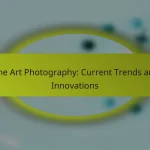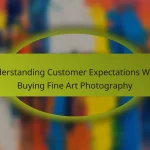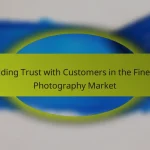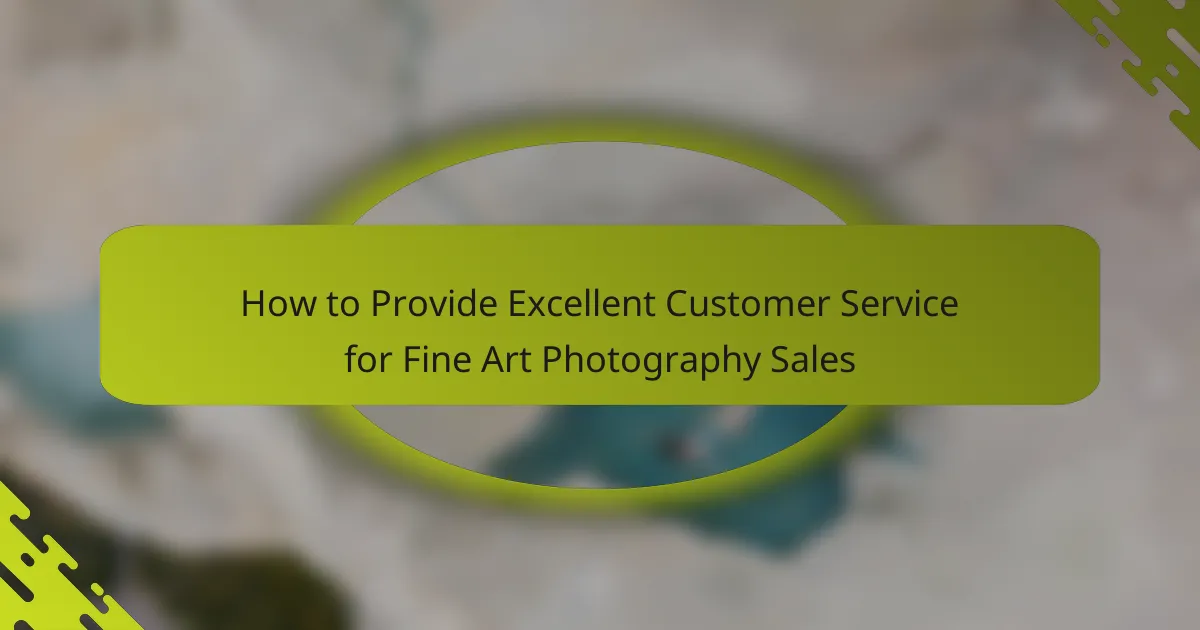Building trust with customers in the fine art photography market is essential for fostering long-term relationships and encouraging repeat business. By focusing on high-quality images, transparent pricing, and exceptional customer service, photographers can establish credibility and reliability. Additionally, effective branding and active engagement on social media further enhance customer confidence and loyalty.

How can fine art photographers build trust with customers?
Fine art photographers can build trust with customers by ensuring high-quality images, transparent pricing, and excellent customer service. Establishing credibility through these elements fosters a reliable relationship with clients, encouraging repeat business and referrals.
High-quality product images
High-quality product images are essential for fine art photographers to showcase their work effectively. Clear, well-lit images that accurately represent the artwork help customers feel confident in their purchase decisions. Consider using professional photography techniques and editing software to enhance the visual appeal of your pieces.
Additionally, providing multiple angles and close-up shots can give potential buyers a better understanding of the artwork’s details and texture. This transparency in presentation can significantly boost customer trust.
Transparent pricing
Transparent pricing is crucial in the fine art photography market, as it helps customers understand what they are paying for. Clearly outline the costs associated with each piece, including any framing, shipping, or handling fees. Avoid hidden charges that could lead to customer dissatisfaction.
Consider offering a pricing structure that reflects the quality and uniqueness of your work, such as tiered pricing based on size or limited editions. This clarity can enhance customer confidence in their investment.
Customer testimonials
Customer testimonials serve as powerful endorsements for fine art photographers. Positive reviews from satisfied clients can significantly influence potential buyers’ decisions. Encourage customers to leave feedback on your website or social media platforms to build a collection of testimonials.
Showcasing these testimonials prominently can reassure new customers about the quality of your work and your reliability as a seller. Consider including images of the purchased artwork in the testimonials to create a more personal connection.
Secure payment options
Offering secure payment options is vital for building trust in the fine art photography market. Customers need to feel confident that their financial information is protected during transactions. Utilize reputable payment processors that comply with industry standards for security.
Consider providing multiple payment methods, such as credit cards, PayPal, or other digital wallets, to accommodate customer preferences. Clearly communicate your security measures on your website to further reassure buyers.
Responsive customer service
Responsive customer service is key to fostering trust with customers in fine art photography. Being available to answer questions or address concerns promptly can enhance the overall customer experience. Aim to respond to inquiries within a few hours, if possible.
Consider offering multiple channels for customer support, such as email, phone, and live chat. This accessibility demonstrates your commitment to customer satisfaction and can lead to positive word-of-mouth referrals.

What role does branding play in customer trust?
Branding is crucial in establishing customer trust within the fine art photography market. A strong brand conveys professionalism and reliability, making potential buyers feel more confident in their purchasing decisions.
Consistent visual identity
A consistent visual identity helps reinforce brand recognition and trust. This includes using the same color palette, typography, and logo across all platforms, from your website to social media and marketing materials.
For example, if your photography features a specific style or theme, ensure that your branding reflects this aesthetic. This coherence not only attracts your target audience but also builds a sense of familiarity and reliability.
Professional website design
A professional website design is essential for building trust with customers. It should be visually appealing, easy to navigate, and optimized for mobile devices. A well-structured site can significantly enhance user experience, encouraging visitors to explore your portfolio and make purchases.
Consider including high-quality images of your work, customer testimonials, and clear calls to action. These elements can help create a trustworthy online presence that resonates with potential buyers.
Clear brand messaging
Clear brand messaging communicates your values and unique selling points effectively. This includes a concise description of your artistic vision, the story behind your work, and what sets you apart from competitors.
Use straightforward language and avoid jargon to ensure your message is accessible to a broad audience. Regularly update your messaging to reflect any changes in your work or market trends, which helps maintain relevance and trustworthiness.
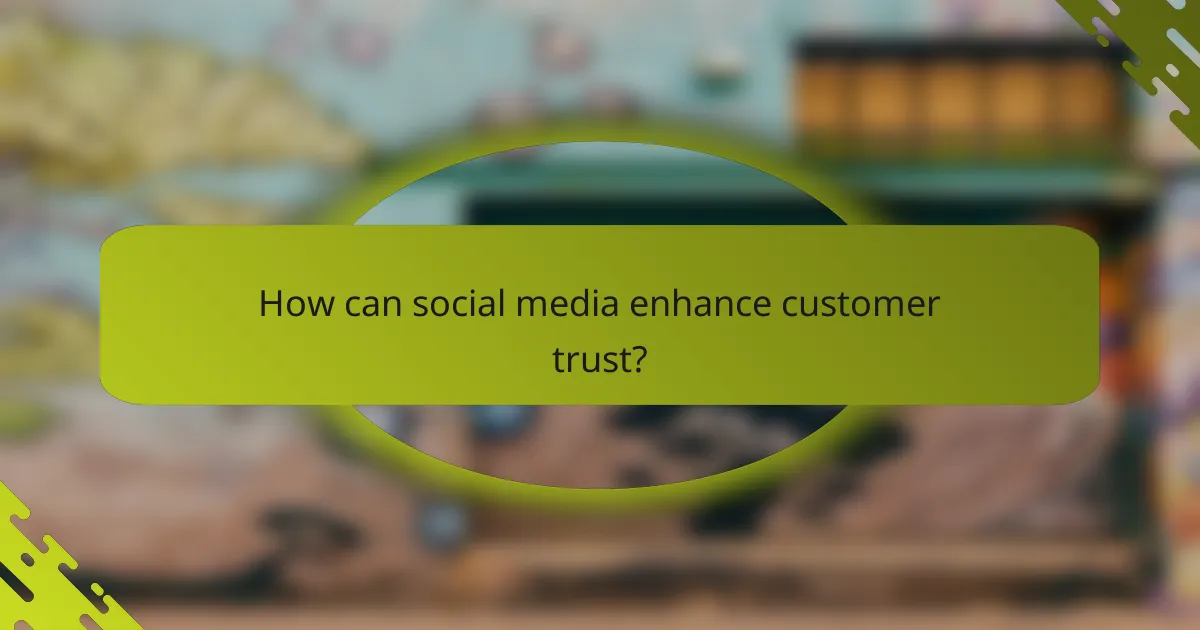
How can social media enhance customer trust?
Social media can significantly enhance customer trust by fostering transparency and engagement. By actively sharing content and interacting with followers, fine art photographers can build a loyal community that feels connected to their brand.
Engaging content sharing
Sharing engaging content on social media allows photographers to showcase their work and personality. High-quality images, informative posts, and storytelling can captivate potential customers and encourage them to follow and engage with the brand.
Consider using a mix of formats, such as videos, carousel posts, and live streams, to keep the content fresh and appealing. Regularly posting behind-the-scenes looks at your creative process can also enhance interest and connection.
Behind-the-scenes insights
Providing behind-the-scenes insights helps demystify the art creation process and builds authenticity. Sharing stories about your inspirations, challenges, and techniques can make your work more relatable and trustworthy to customers.
Use platforms like Instagram Stories or Facebook Live to offer real-time glimpses into your workflow. This transparency can foster a deeper emotional connection with your audience, making them more likely to support your work.
Real-time customer interaction
Real-time interaction with customers on social media can significantly boost trust. Responding promptly to comments, messages, and inquiries shows that you value customer engagement and feedback.
Consider hosting Q&A sessions or interactive polls to encourage participation. Additionally, acknowledging customer feedback publicly can enhance your reputation and demonstrate commitment to your audience’s needs.

What are the best practices for customer reviews?
Best practices for customer reviews in the fine art photography market include encouraging honest feedback, responding thoughtfully to reviews, and showcasing positive testimonials. These strategies help build trust and credibility with potential buyers.
Encouraging honest feedback
To foster genuine customer reviews, create an environment where clients feel comfortable sharing their thoughts. Send follow-up emails after a purchase, inviting them to provide feedback on their experience. Consider offering small incentives, such as discounts on future purchases, to motivate customers to leave reviews.
Make it easy for customers to leave feedback by providing direct links to review platforms or your website. Ensure that your request is clear and straightforward, emphasizing the value of their opinions in helping you improve your offerings.
Responding to reviews
Responding to reviews, both positive and negative, demonstrates that you value customer input. Acknowledge positive feedback with gratitude, and consider highlighting specific aspects of the review to show you genuinely appreciate their support.
For negative reviews, address concerns promptly and professionally. Offer solutions or alternatives where possible, and invite the customer to discuss their experience further. This approach can turn a dissatisfied customer into a loyal one by showing your commitment to their satisfaction.
Showcasing positive testimonials
Highlighting positive testimonials can significantly enhance your reputation in the fine art photography market. Create a dedicated section on your website for customer reviews, featuring quotes and images of the artwork purchased. This not only builds credibility but also provides social proof to potential buyers.
Consider sharing testimonials on your social media platforms to reach a broader audience. Visual content, such as images of satisfied customers with their purchased art, can be particularly compelling and encourage others to engage with your brand.

How can fine art photographers ensure secure transactions?
Fine art photographers can ensure secure transactions by implementing robust security measures that protect both their artwork and their customers’ financial information. This includes using encryption technologies, trusted payment systems, and proactive fraud detection strategies.
Using SSL certificates
SSL certificates encrypt data transmitted between the photographer’s website and the customer’s browser, ensuring that sensitive information remains confidential. By displaying a padlock icon in the browser’s address bar, SSL certificates provide visual assurance to customers that their transactions are secure.
Photographers should obtain an SSL certificate from a reputable provider and install it on their website. Regularly updating and renewing the certificate is crucial to maintain security and customer trust.
Offering trusted payment gateways
Using established payment gateways like PayPal, Stripe, or Square can enhance transaction security. These platforms have built-in fraud protection and comply with industry standards, which helps to reassure customers about the safety of their financial information.
Photographers should clearly display accepted payment methods on their website and ensure that the payment process is straightforward and user-friendly. This transparency can significantly increase customer confidence in making purchases.
Implementing fraud detection measures
Fraud detection measures, such as monitoring transaction patterns and using tools that flag suspicious activity, are essential for protecting both the photographer and the customer. Implementing these measures can help identify and prevent fraudulent transactions before they occur.
Photographers can utilize services that offer real-time fraud detection and alerts. Regularly reviewing transaction reports and being vigilant about unusual activity can further enhance security and build customer trust.
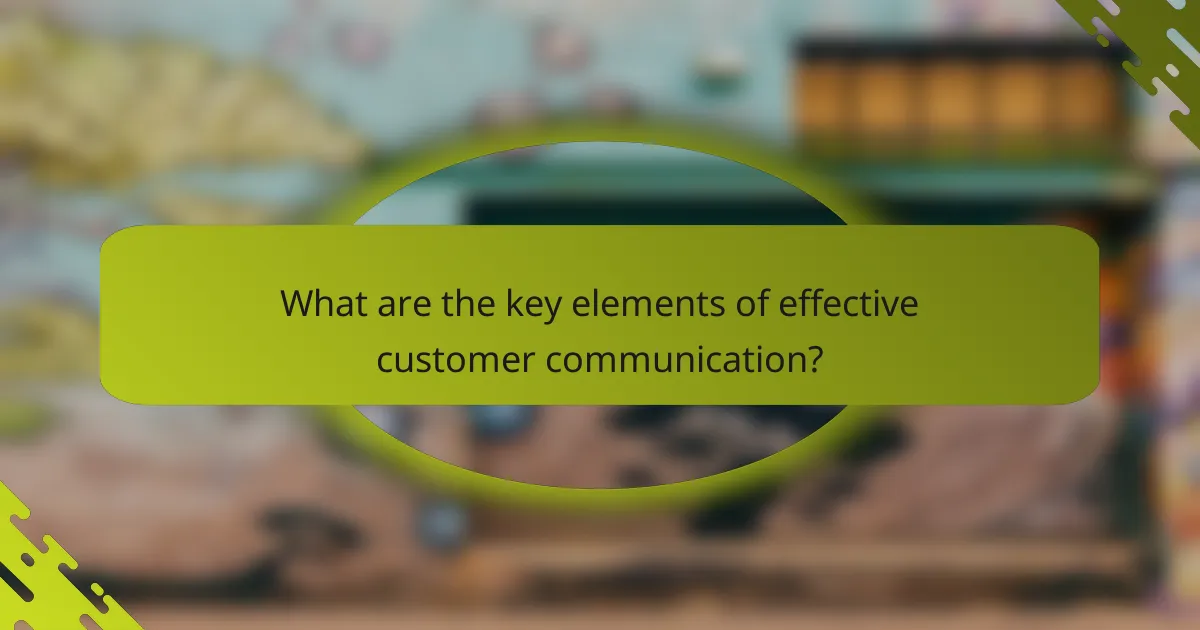
What are the key elements of effective customer communication?
Effective customer communication in the fine art photography market hinges on clarity, responsiveness, and empathy. Building trust requires consistent engagement that addresses customer needs and fosters a genuine connection.
Clarity in Messaging
Clear messaging is essential for effective communication. Use straightforward language to describe your artwork, pricing, and policies, avoiding jargon that may confuse potential buyers. For instance, when discussing pricing, specify whether it includes framing or shipping to prevent misunderstandings.
Consider using visuals alongside text to enhance understanding. High-quality images of your work can convey details that words may not fully capture, helping customers make informed decisions.
Timely Responses
Responding promptly to inquiries is crucial in building trust. Aim to reply within a few hours, especially during business hours, as this shows customers that you value their interest. A delay can lead to frustration and may result in lost sales.
Utilize automated responses for initial inquiries, but ensure that follow-ups are personalized. This balance maintains engagement while allowing you to manage your time effectively.
Empathy and Personalization
Understanding and addressing customer emotions can significantly enhance communication. Take the time to listen to their needs and preferences, which can help tailor your approach. For example, if a customer expresses a desire for a specific style, recommend pieces that align with their taste.
Personalized communication, such as addressing customers by name and referencing past interactions, fosters a sense of connection. This approach can encourage repeat business and referrals.

